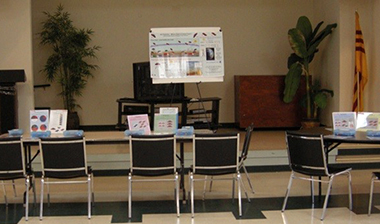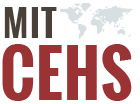Youth Environmental Health
The MIT CEHS COE2C is eager to share environmental health knowledge with youths across the nation through afterschool clubs, community events, and summer camps.
National Distribution of Lesson Materials with Training for Educators in Climate Change and Air Pollution.
The concepts we seek to share are the basic scientific facts behind climate change and air pollution effects on environmental public health. Both topics are timely, and towards this end in August 2013, the COE2C Director, Dr. Kathy Vandiver, presented a lesson to a national audience entitled, “Understanding Air: Climate Change and Air Pollution,” as part of a PEPH Webinar: “Reaching our STEM potential.” ("STEM" stands for Science Technology Engineering and Math).
In accordance with NIEHS guidelines, no NIEHS funds were used in development of the K-12 curriculum. This work is a collaborative effort with MIT’s Edgerton Center. The “Atoms and Molecules Set” materials are currently available for distribution from the MIT Edgerton Center.
Description of the lesson materials.
Dr. Vandiver developed a series of exemplary middle school lessons that utilize LEGO® bricks as atoms to model elements, compounds, and mixtures. With these familiar tools, students can easily model what happens to the fuel and oxygen atoms in a car engine during combustion: the same atoms (bricks) become refigured into water and carbon dioxide! These independently experienced a-ha! moments are orchestrated by using laminated mats printed with life-sized LEGO brick shapes as guides. The common air pollutants generated inside combustion engines, such as carbon monoxide become self-evident whenever a fuel to oxygen imbalance occurs. The CEHS atmospheric chemists were involved as advisors on the combustion chemistry episodes.
Overall, the LEGO bricks communicate environmental health messages in a memorable way because it’s fun to make playful discoveries. Not only can educators now readily utilize these instructional to reach youths in afterschool programs to get the key concepts across, but older youths can become teachers too. With a little training, older youths can manage a LEGO activity station and their participation can be a point of pride at a community health fair.

Partnership with the i2 STEM Camp to help youths become engaged and interested in Environmental Health.
In collaboration with MIT's Edgerton Center, the course in Environmental Health Science called "Toxin Trackers" was developed for the 5-day youth camp. This course was successfully piloted at two i2Camps locations, in NYC and Boston, during the summer of 2014. The curriculum plan for juniors (5th and 6th graders) and the seniors (7th and 8th graders) included the following 6 major activities and utilized some of the core concepts from the Atoms and Molecules Set lessons:
- EHS role playing with a computer game designed at MIT
- Modeling combustion activities with the Atoms & Molecules Sets
- Field studies in Air Quality with a Dylos™ PM meter
- Field studies in H2O Quality with BioPaddles™ & LaMotte tests
- Airway health studies with Peak Flow Measurements of airways
- Visiting a local wastewater treatment facility on a half day fieldtrip
Overall, the i2 STEM Camp is expanding rapidly to 15 cities nationally and 1 internationally in 2014, up from just two sites in 2013.
This could be an incredibly valuable way to help middle-school-aged children become interested and engaged in the challenges we face with environmental health today.

